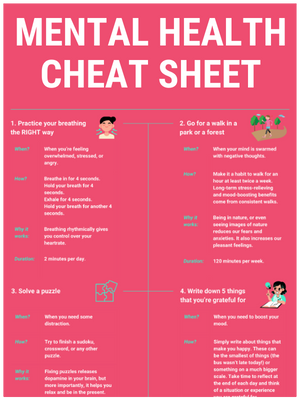Picture this… You have a day full of moments that make you smile. But for some reason before bed, all you can think about are the five minutes of the day where something went wrong. This type of thinking can be explained by the negativity bias.
All of us occasionally fall into the trap of this negativity bias that causes us to feel negative events more strongly than positive ones. Living with this mindset can lead to depression and becoming a negative Nancy. With awareness, you can overcome this bias to see all the good that surrounds you every day.
This article is here to help you understand negativity bias and how to overcome it on a daily basis. All it takes is a bit of insight to learn how to consistently turn your frown upside down.
Contents
What is the negativity bias?
Negativity bias is the idea that we are impacted more by negative events than positive events in our lives. And we tend to pay more attention to negative circumstances relative to positive ones.
To put it simply, it’s as though we are wired to notice and focus on the bad.
And it appears that we learn the negativity bias early on in life. Research confirms that even infants and young children exhibit negativity bias.
It would seem that no one is exempt from experiencing the negativity bias. That’s why it’s important that we learn how to actively counter this bias.
What are examples of negativity bias?
You might be wondering what negativity bias looks like in the real world. I’m here to tell you that I experience it almost on a daily basis at work.
I get home from work and I can remember the one patient where I feel like I failed. All the rest of my patients may have been feeling better and stoked about the physical therapy I provided.
Yet, I ruminate on the one person who isn’t responding to treatment. And then I say things like, “I’m a terrible physical therapist. What’s the point?!”.
Luckily, my husband talks me off the ledge and points out all the positive outcomes. I then let it go and try again the next day.
Another common example of negativity bias is often seen in relation to harsh comments.
I can still remember to this day when my ex-boyfriend in high school told me I had a “five-head”. I can picture where I was standing and what I was wearing.
Now ask me about where I was when he first told me I was beautiful or when he complimented my prom dress? I can’t remember.
What’s engraved into my brain is the hurtful comment. Because that’s what my brain prioritizes.
I bet if you think about it, it’s easier for you to remember a hurtful comment compared to a compliment.
Studies on negativity bias
If you’re like me, you’d like to think you’re the eternal optimist. And that may be true, but studies show that negativity bias is a real phenomenon that affects us all.
A study in 2017 found that negativity bias is particularly present when it comes to how we translate social information to each other. This research indicated that people are more likely to discuss negative events than positive ones.
And a study in 2019 indicated that negativity bias is not connected to just one culture. After examining how the news affected multiple cultures, the negativity bias remained king. Negative news received more attention and spread more readily.
How does the negativity bias affect your mental health
It only makes sense that if we focus more on the negative, we are bound to feel unhappy. And science confirms that giving into negativity bias may heighten your anxiety.
Research has found that negativity bias causes an increased startle response and heart rate. It also increased the activation of “fear” centers in our brains. These physiological effects are why we are more likely to feel anxious when consumed by negativity bias.
I can relate to this personally as my anxiety is often triggered when I am fixated on negative circumstances.
Today I turned on the news and I was immediately overwhelmed by the war in Ukraine, inflation, and S&P 500 forecasts. I start to focus on everything that is wrong and spiral downward in a circle of anxiety.
All the while today was actually a great day with beautiful monsoon rain and time with my dog. But the negativity bias clouds moments of gratitude and leaves me feeling endlessly anxious.
5 tips to overcome negativity bias
If you’re ready to spread sunshine and give the negativity bias the boot, then these 5 tips were made just for you.
1. Let yourself feel first
This may sound counterproductive, but first, you need to let yourself feel negative. If you just brush off the negative event, you’re not letting yourself handle your emotions.
But there is a difference between allowing yourself to feel the negative moment versus dwelling on the negative moment.
Remember the example regarding how I’ll fixate on the one patient that didn’t respond how I’d hoped? I’ve developed a new strategy for dealing with this since it’s recurring for me.
I allow myself to feel bummed for up to five minutes. I literally set a timer. Once those five minutes are up, I force myself to both literally and metaphorically say goodbye to that emotion.
By giving myself healthy space to feel my emotions, I’m not dismissing them as though they aren’t real. But I’m also not allowing them to dictate my emotions for an entire evening.
Let yourself feel it because by processing your emotions in a healthy manner the negative event no longer has power over you.
2. Use the 3:1 rule
A rule I come back to time and time again is what I call my 3:1 rule. Essentially, anytime you say one thing negative you have to come up with three positive things.
You’d be surprised how many times throughout the day you are probably drowning in your own negative comments. This rule forces you to actively focus on more positive aspects.
Any time I do this, it’s almost an immediate mood changer. It’s also helped me learn to complain less.
This simple rule helps me realize there is always so much good to focus on if I will actively make the choice to see it.
3. Have happy strategies set up
If you’re having a day where you’re drowning in negativity, you need to have a set of happy strategies. In my case, I have a list of things to do that will help me focus on the good things in life.
My list includes things like:
- Dancing to my favorite music.
- Going for a long walk with my dog while listening to a podcast.
- Spending time reading outside on the grass.
My list goes on and on, but I won’t bore you with my interests. Doing any one of these things immediately programs my brain to feel good and focus on the beauty in life.
You need to have your own personal strategies for combating an inherent bias to focus on the bad. Because there will inevitably be days where you need to fall back on this list to reset your mindset.
4. Keep a record of “the good”
When you’re having a hard time focusing on the good, having your life highlights readily available can be a useful tool.
Whenever something really good happens to me now, I write it down on a small piece of paper. I then put this paper in a jar that I call my “life wins” jar.
I’ve written down everything from running my first trail race to marrying my husband. You can write down big wins and small wins.
Now when I’m having a particularly rough day, I pull a few pieces out of my “life wins” jar. It only takes reading a few to remember that no matter what happens life is full of good moments.
You don’t have to have a jar. You could make a list on the Notes app on your phone. Or you could have a journal dedicated to happy moments.
Having these positive memories in one place helps make the effort of finding the good on the bad days that much easier.
5. Rewrite the story
This last tip is one that I still am practicing myself. Some of our negativity bias is because we are choosing to see the situation as bad to begin with.
If something less than desirable happens, you may need to rewrite the story you are telling yourself about the situation.
When I’m remembering something bad that happened during my day, I try to start by asking one question now. I ask myself, “How could this be a good thing?”.
My gut answer is nothing is good about it. Once I get past my gut reaction and reflect on the question, I can usually reframe the situation to find the silver lining.
Just the other day I was having a great day until I got a flat tire on the way home. At the moment, all I could do was focus on how this was going to cost me money and time.
Once I got home though, I had a moment to breathe and asked myself the question. I realized that by being stuck waiting for a new tire I had a chance to talk to my mom on the phone. And I had a front-row seat to a lightning storm that was beautiful.
If it seems impossible to stop focusing on the negative, then it’s time for you to rewrite the story. Flip the script and turn the negative into a positive.
💡 By the way: If you want to start feeling better and more productive, I’ve condensed the information of 100’s of our articles into a 10-step mental health cheat sheet here. 👇
This Cheat Sheet Will Help You Be Happier and More Productive
Thrive under stress and crush your goals with these 10 unique tips for your mental health.
Wrapping up
The negativity bias is a real biologically hardwired phenomenon. But lucky for us, biology alone doesn’t determine our destiny. With the tips from this article, you can fight off the natural inclination to find and focus on the negative stuff in life. And with practice, you may discover that the good in the world will always outweigh the bad.
How have you recently handled a negative situation in a positive way? What’s your best tip to overcome negativity bias? I’d love to hear from you in the comments below!



Good ideas. I’m looking for ways to help my granddaughter get out of her negativity bias clouds.